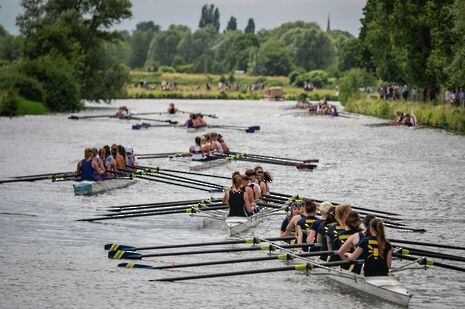Varsity explains: how does rowing work?
Joseph Krol explores the fluid dynamics behind that most Cambridge of pastimes: rowing

How difficult can it be to explain something as simple as how a boat moves through the Cam? Although on the face of it it's a fairly simple mechanism, the fluid dynamics behind it is quite complex and not entirely well-understood – there's perhaps more to it than you think.
There are several structurally distinct sources of drag on a rowing boat as it moves. For instance, some is generated on the base of the boat, essentially because as the boat moves quickly over stationary water, it accelerates the water directly below it, causing energy loss. However, the principal source of drag comes from perhaps the most intuitive source – the water hitting the profile of the boat as it moves along.
The Reynolds number, named for a Queens’ College mathematician, is a dimensionless quantity that essentially compares the strengths of the forces due to inertia and the forces due to viscosity in a system. On the scale of rowing boats, the Reynolds number turns out to be relatively high, and as such the inertial drag on the boat is roughly proportional to the square of the velocity. The power that the rowers must then exert in order to keep a steady speed is given by the product of this force that they are working against and the velocity at which they are moving, making it proportional to the cube of the velocity. In other words, in order to double the speed at which they are travelling, each rower must put in about eight times as much effort.
Beyond simple heuristic arguments like this, the maths quickly gets very rather ugly. Indeed, the equations that flow like this has to satisfy are notoriously difficult to solve – even the fact they have unique solutions is unproven, and would win the person who proves it a million-dollar sum. Given that many of the specific studies only took place over the last couple of decades, with many avenues yet to be explored, it may well be a case in which the rowers’ intuition has outpaced even the most earnest fluid dynamicists.
 News / Clare Hall spent over £500k opposing busway 24 December 2025
News / Clare Hall spent over £500k opposing busway 24 December 2025 Comment / The ‘class’ of Cambridge24 December 2025
Comment / The ‘class’ of Cambridge24 December 2025 News / Caius mourns its tree-mendous loss23 December 2025
News / Caius mourns its tree-mendous loss23 December 2025 Comment / League tables do more harm than good26 December 2025
Comment / League tables do more harm than good26 December 2025 News / Girton JCR publishes open letter expressing solidarity with Palestine25 December 2025
News / Girton JCR publishes open letter expressing solidarity with Palestine25 December 2025








